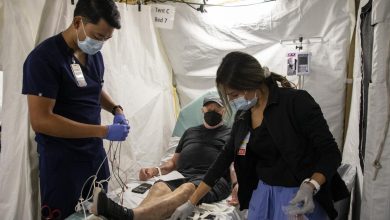Weiss Hospital to Close Friday — Is This the End for Chicago’s Safety-Net Care?

When the doors of Louis A. Weiss Memorial Hospital were found locked one August morning, it felt to many on Chicago’s North Side like the city had lost an anchor. Weiss — a 236-bed safety-net hospital that has served Uptown and surrounding neighborhoods for decades — ceased inpatient operations Friday, with its emergency room, intensive care unit, surgeries and inpatient floors shuttered while some outpatient services continue to operate more like clinics. The closure follows an extraordinary blow: the federal Centers for Medicare & Medicaid Services (CMS) moved to terminate Weiss’s participation in Medicare and Medicaid, the two programs that account for the vast majority of the hospital’s revenue.
The immediate scene — patients being redirected, staff scrambling, a community rallying outside a darkened emergency entrance — is the most visible sign of a deeper, systemic problem that is now playing out in real time: what happens when a safety-net hospital fails regulatory standards and the financial lifeline that keeps it afloat is cut? For Uptown residents — a demographically diverse, largely lower-income population that includes many older adults and people of color — the loss of Weiss represents not just inconvenience but a potentially life-altering reduction in access to timely care.
How we got here: compliance problems meet brutal economics
The path to Weiss’s closure was paved by regulatory findings and an accumulation of operational failures. State investigators had repeatedly found Weiss out of compliance on core standards — from nursing staffing levels and emergency services to the physical environment of the hospital. Local reporting documents episodes that alarmed regulators: makeshift emergency areas with insufficient medications and oxygen supplies, air-conditioning failures that forced patient transfers in the heat, and chronic staffing shortages that raised questions about patient safety. CMS sent a formal letter in late July notifying the hospital of termination from Medicare, and that move triggers automatic exclusion from Medicaid as well — a crippling blow for a hospital that relies on federal insurance payments for the bulk of its income.
To put the financial stakes in plain terms: analyses show that Medicare and Medicaid can make up more than 80% of some safety-net hospitals’ revenue. Losing them overnight makes it virtually impossible to continue inpatient services, pay staff, and keep high-cost programs running. Hospital owners and operators say the hospitals they inherit are often already struggling; regulators say patient safety and minimum standards cannot be compromised. The collision of those realities is what we’re seeing at Weiss.
The human cost: neighborhoods, ERs, and fragile networks
Weiss isn’t just a building; it’s integrated into the health care fabric of several Chicago neighborhoods. Thousands of residents — many without private insurance or reliable transportation — have used Weiss for primary care, emergency care and specialty services for generations. For them, the closure means longer trips to other hospitals, stretched emergency departments elsewhere, and sometimes delayed care. Community activists and local elected officials at the hospital gates described fear and anger: they called Weiss a “lifeline” and demanded immediate intervention to prevent what they called a “community disaster.” Patients and staff alike expressed bewilderment and grief.
On a practical level, the closure forces neighboring systems to absorb additional patients. Hospitals such as Thorek Memorial and Swedish Covenant were named as destinations for transfers; but hospital capacity is finite, and suburban and city hospitals already operating at or near capacity risk further strain. For emergency medical services, response times and transport distances can increase, which has measurable impacts on outcomes for time-sensitive conditions like strokes and heart attacks. For chronic conditions that depend on continuity — dialysis, wound care, behavioral health — the disruption can degrade long-term outcomes.
Political flashpoint: who’s to blame and who will act?
Unsurprisingly, Weiss’s closure immediately became a political flashpoint. Local and state leaders petitioned CMS for an extension and urged state intervention. Illinois representatives and city council members tried to buy time: some asked for an eight-week extension of Medicare certification; others called for the state to provide emergency funding or to facilitate a transfer of services to other providers. Senators and congressional representatives echoed concerns about the loss of a safety-net resource for a vulnerable population. Hospital ownership — Resilience Healthcare, led by Dr. Manoj Prasad — blamed previous owners and employees who filed complaints, while acknowledging the hospitals need capital and operational fixes. Regulators insisted the action reflects months of failures to address patient safety and compliance. The standoff raises a broader question: when regulators step in to protect patients, who pays to preserve the community’s access to care?
This tension — between enforcing standards and preserving access — is an old one in health policy. CMS cannot allow a hospital to operate in ways that put patients at risk. But the blunt tool of termination, especially when applied to a hospital with such a thin financial margin, quickly becomes a blunt instrument for community injury. That is one reason state and local leaders often scramble to broker temporary extensions, infusion of funds, or sale to another operator — if, and only if, the new plans include credible fixes to the safety problems that triggered the federal action.
The broader picture: are other safety-net hospitals at risk?
Weiss’s fate is not happening in isolation. Across the country, many hospitals that serve high proportions of Medicare, Medicaid, and uninsured patients operate on slim margins. Policy changes, reimbursement pressures, staffing shortages, and pandemic hangovers have pushed some to the brink. In Chicago, other community hospitals have watched Weiss’s troubles with alarm, because the closure of one safety-net provider creates ripple effects that can destabilize nearby institutions. At least one sister hospital — West Suburban Medical Center, also owned by Resilience Healthcare — has been flagged by its owner as facing financial pressure, prompting fears it could follow in Weiss’s footsteps.
The national policy response to hospital vulnerability has historically been ad hoc. Some communities invest public funds to keep essential hospitals afloat; others arrange mergers or service consolidations. But these are politically fraught and legally complex maneuvers, and they take time — sometimes more time than regulators or communities have once a provider is cut from federal programs.
Possible paths forward
When a safety-net hospital is shuttered, successful responses usually fall into a few categories — each with tradeoffs.
- Emergency funding and temporary certification extensions. Local officials can petition federal and state agencies for brief stays that give hospital operators time to fix problems. Extensions can preserve access short-term but only if leaders can identify immediate, credible operational fixes and money for staffing and capital repairs.
- State takeover or public-private partnership. Some cities have worked with state governments to create temporary management or oversight arrangements, sometimes converting hospitals into public entities or brokered partnerships. This approach can stabilize services but requires political will and substantial funding.
- Sale or transfer to a well-capitalized health system. Larger health systems may be able to buy or partner with struggling hospitals and absorb deficits while instituting safety and quality improvements. However, buyers aren’t always available — and a sale to an out-of-state or for-profit operator raises concerns about mission alignment for vulnerable populations.
- Decentralization into community clinics and targeted services. Where inpatient services cannot be immediately preserved, maintaining outpatient care — primary care clinics, behavioral health, and specialty clinics — can soften some impacts. This effectively makes the facility a healthcare hub rather than a full hospital, but it cannot replace emergency or inpatient capacity.
At Weiss, community leaders were reportedly working with the owner and with state officials to explore one or more of these options — while CMS and the Illinois Department of Public Health held to their positions on patient safety. The question is whether a workable plan can be put in place quickly enough to prevent permanent loss of hospital services in Uptown.
What patients and staff are hearing — and what they need to know
For patients, the immediate practical steps are straightforward but stressful: if you have appointments at Weiss, call ahead to confirm whether outpatient services (radiology, cardiology, women’s health, orthopedics, behavioral health and internal medicine) are still running and if your care has been transferred. If you have chronic care needs like dialysis, find out where your treatments will be shifted. And if you have an emergency, familiarize yourself with nearby emergency departments and transport options — delays or confusion in an emergency can be dangerous. Block Club and other local outlets listed transfer destinations and service changes as they developed; use official hospital communications or your insurer’s network information to verify specific redirects.
For staff — nurses, techs, therapists — the closure brings sudden job insecurity in a sector already strained by shortages. Employees may be transferred to other local hospitals if those systems can absorb them, but many will face layoffs or furloughs in the short term. Unions, local electeds and advocacy groups are pushing for measures to protect staff and ensure continuity of care.
Lessons for policymakers and funders
Weiss’s crisis spotlights long-standing policy challenges that go beyond any single operator’s competence:
- Regulation vs. rescue. Regulators are right to protect patients, but the system lacks a predictable, rapid backstop for lifesaving institutions that fail compliance. Policymakers could consider contingency funds or fast-track remediation processes that require transparent improvement plans in exchange for temporary funding.
- Sustainable funding for safety-net care. Reliance on Medicare and Medicaid — themselves under funding pressures — makes hospitals vulnerable. States and municipalities might explore supplemental support mechanisms or payment reforms that stabilize revenue for hospitals that disproportionately care for low-income populations.
- Workforce resilience. Chronic staffing shortages undermine quality and trigger regulatory actions. Investments in recruitment, training pipelines, and retention — including competitive pay and safe staffing mandates — are essential.
- Community voice in solutions. Any plan to preserve services should center the residents who depend on them. Community clinics, advisory boards and local health partnerships can help ensure that solutions match local needs.
None of these reforms are quick; they require sustained political will and money. But the Weiss episode is a stark reminder that relying on patchwork responses invites crises that inflict real human harm.
Final look: an end — or a turning point?
Is this the end of Chicago’s safety-net care? Not necessarily — but Weiss’s closure is an alarm bell. The loss of a hospital is rarely a single institution’s failure; it reflects the interplay of regulation, funding, ownership decisions, workforce realities and political will. What happens in the coming weeks — whether a temporary reprieve, a sale to another operator, state intervention, or a permanent downsizing of services — will be both a local and a policy test. If Chicago and Illinois can mobilize resources and political consensus to reimagine how to protect vulnerable communities’ access to care — and do so while holding safety and quality as nonnegotiable — then the Weiss crisis could become a catalyst for reform. If not, it will be a cautionary tale about what happens when safety standards collide with economic fragility in systems that many of our neighbors depend on for survival.




